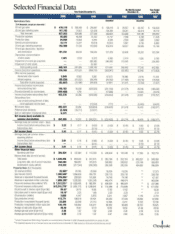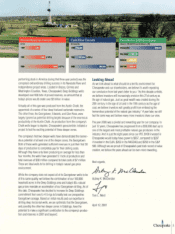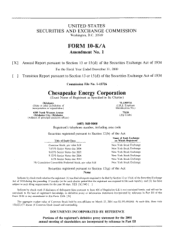Chesapeake Energy 2000 Annual Report Download - page 5
Download and view the complete annual report
Please find page 5 of the 2000 Chesapeake Energy annual report below. You can navigate through the pages in the report by either clicking on the pages listed below, or by using the keyword search tool below to find specific information within the annual report.
needed to adjust our business model to accept the limitations ot
slower tuture growth while lowering our risk protile, we embarked on
the most ambitious corporate makeover the industry has seen during
the past 10 years.
The fundamental goal in our transition was simple: we decided to
acquire as many natural gas reserves as we could afford, ultimately
acquiring 750 billion cubic teet ot natural gas equivalent (bcte) tor
$750 million in six months. Although our acquisition pricing was
considered aggressive at the time, in retrospect our purchases have
proved to be great bargains.
Why Natural Gas vs. Oil?
Heavily influenced by our own experiences on the front lines search-
ing for large new reserves of natural gas, we believed it would be
almost impossible for our industry to meaningfully increase the sup-
ply of natural gas in the years ahead. We also recognized that a
growing economy, stricter environmental regulations and the coming
onslaught of gas-tired electrical generation would serve as catalysts
for strong natural gas demand growth and, almost certainly, higher
natural gas prices.
In addition, we significantly lowered our risk profile by focusing
Chesapeake's search for natural gas reserves in our own backyard of
the Mid-Continent region (Oklahoma, the Texas Panhandle, and SW
Kansas) and by growing through a balanced development program of
both drilling and acquisitions.
The Downturn of '98
By mid-1998 we believed our strategic transformation was complete
and would provide a strong base for the company to return to indus-
try prominence. Unfortunately, we were a bit early. External factors
such as the Asian financial crisis, three of the warmest winters of the
20th century and an oil production miscalculation by OPEC caused
oil and natural gas prices to fall to 30-year inflation-adjusted lows by
early 1999.
It was a time when the "experts" were all in agreement: oil and natu-
ral gas prices would remain low indefinitely, E&P companies were
fundamentally flawed businesses (we spent too much, didn't find
enough, were too small to matter, were too "old economy", etc), and
worst of all E&P management teams were alleged to have consis-
tently destroyed value over the previous 15 years.
Unlike some of our peers who elected to sell assets (or their compa-
nies) at the bottom of this cycle, we were confident that Chesapeake's
strategic repositioning had been well-executed and that a cyclical
upturn in oil and natural gas prices was inevitable. The rest, as they
say, is history. In early 1999 investors could have acquired all of
Chesapeake's common stock as the equivalent of a five-year call
option on over a trillion cubic feet of natural gas for less than $100
million. Today, the present value of our reserves is over $3.2 billion.
California and the U.S. Energy Crunch
We believe this review of where we've been is not just important for
your understanding of why Chesapeake's strategy is working, but it's
also critical to understanding almost everything about the energy
business today. California's electricity and natural gas shortages,
high oil prices worldwide, high natural gas prices, potential electricity
shortages this summer in NYC and in the Midwest, and finally, a
possible replay of this in 2002 all of these problems have their
roots in the low energy prices and energy policy complacency of the
past 15 years.
In a nutshell, when a country embarks on a binge of energy con-
sumption (electricity usage is up 43% since 1985) and fails to invest
enough in its energy supply and delivery infrastructures along the
way, something has to give. That something is always price.
It's the Producers and their Shareholders' Turn Now
As it turns out, we and other E&P management teams have not done
such a poor job of creating value during the past 15 years. It's simply
that the value we created through the expensive, risky and time-con-
suming search for new supplies of energy was transferred to
American consumers rather than to our industry's shareholders as a
result of excess supplies of oil, natural gas and electricity. The net
result of this extended period of low energy prices was a 15-year
boom in U.S. and worldwide growth from 1985-2000 (obviously
accelerated by enormous technological advancements) that gradually
eliminated the excess supply of electricity, natural gas and oil.
As we have all learned over the years, what goes around comes
around and the imbalance is now in favor of energy producers.
Today, we are in an environment where enormous value is being
created by Chesapeake and our industry. This time, however, that
value is being retained by our shareholders. Persistently high energy
prices and huge value creation in the energy industry will be a fact of
American life for at least the next five years.
High Energy Prices Will Be With Us for a While
Most Americans do not understand the time and money needed to
make the required energy investments that can increase supply
enough to lower energy prices. Simply stated, it has taken us 15
years to get into the current energy crunch and it's going to take a
while to get out. This will require massive amounts of capital from
investors capital that in the past 15 years has generally been
invested in everything that consumes energy and will now need to be
invested in everything that produces and transports energy. Affecting
such a change in investing preferences won't be easy, but we believe
the market will force it to happen through the twin realizations that
higher energy prices are with us for a while and that energy producers'
stock prices don't reflect the intrinsic value of the assets they own.
Chesapeake 3


















